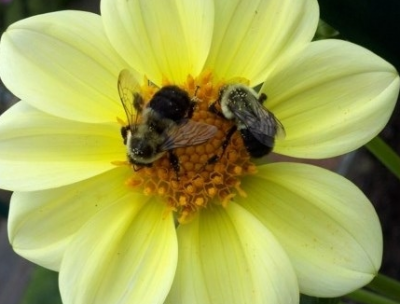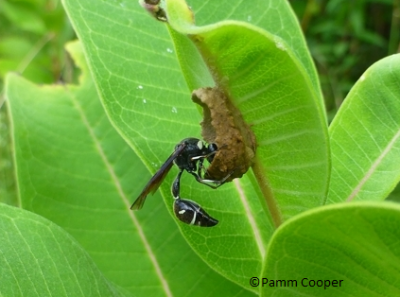Bees and wasps are beneficial insects of the order Hymenoptera. Bees have pollen-carrying hairs while wasps are smooth and almost hairless. Wasps also tend to have slender waists. Pollinators are necessary to produce over 85 crops and bees are among the most vital in the work that they do.
Bees

There are thousands of species of bees, most of which are smaller than the honey bee. Bee communities have been declining over the last half century as pesticide use has increased. Insecticides with long residual toxicity should not be applied by spray, dust, or systemic to plants that are in bloom. If it is absolutely necessary, use an insecticide with the lowest toxicity rating per the EPA (read the label carefully). For additional info see the UMass Amherst Neonicotinoid Turf Insecticides and Pollinators fact sheet.
The most commonly seen bees in New England are European (or Western) honey bees (Apis mellifera), bumble bees (Bombus spp.), ground or mining bees (Colletes inaequalis), and carpenter bees (Xylocopa virginica).
- Honey bees live in colony hives and produce honey and beeswax. The adult are from 0.35 to 0.78" long and can be black, orange, yellow, red, or brown, striped with short hairs. The stinger of the worker honey bee (all females) is barbed so that it stays in the victim's skin. The stinger will pull away from the worker bee which will die shortly after.
- Bumble bees are larger (3/4" long), rounder, and fuzzy. Bumble bees also live in a colony but their nest is smaller than the honey bee's hive. Bumble bee nests can be above ground in thick grass, in abandoned bird or rodent nests, in trees, under sheds, or in shady corners.
- Ground bees, as their name suggests, make their nests underground. There are usually large, cone-shaped piles of sandy soil with a single hole in the center. These are solitary bees. Each female digs her own nest so the sight of many of these near each other in the lawn can be intimidating. The adult ground bee is similar in size to the honey bee and although the female has a stinger it is not aggressive and will not sting unless handled by a human. They are beneficial pollinators and should be left undisturbed. To prevent ground bees from nesting lawns should be kept healthy and vigorous so that there are not areas of empty, sandy soil to attract them.
- Carpenter bees are large, up to an inch long, and similar in appearance to bumble bees although the top of the carpenter bee's abdomen is a shiny black color. Carpenter bees will excavate a round, 1/2" hole into unpainted wood surfaces to create their tunnels. They are not eating the wood. Each spring mated female will lay eggs in several chambers in these tunnels. It is the newly hatched larvae that will pupate, emerge as adults in August, feed and then return to the tunnels to overwinter. The female carpenter bee will sting if provoked.

Wasps
Wasps attack and destroy many thousands of pest insects found around homes and in gardens. Examples of wasps include hornets, yellow jackets, paper wasps, mud daubers and cicada killers.
The parasitic wasps that lay their eggs in or on some insects are commonly from the Braconidae and Ichneumonidae families are generally non-aggressive to humans.
The solitary hunting wasps of the families Sphecidae and Pompilidae dig into soil, create mud nests or excavate in the pith of hollow plants.
The social wasps of the family Vespidae are the group most likely to sting a human. This group constructs the paper nests that can be found below ground, behind an exterior wall, beneath wooden decks, and in the crevices of playground equipment. They are a nuisance around outdoor dining areas and uncovered garbage. Yellow jackets (Vespula spp.) are a part of this group.
Stings
Most wasps and bees withdraw their stingers from victims after stinging. The stingers of honey bees, however, are barbed and remain in the flesh. If not removed, an embedded stinger will continue to pump venom into the wound for a few minutes. Do not pull the stinger out, as that may inject more venom. Scrape the stinger out with a fingernail. Seek guidance for bee stings from medical professionals. If the sting victim has a history of hay fever, asthma or other allergies, call a doctor immediately. Allergic reactions may sometimes be severe or even fatal.
Control
Bees generally do not cause damage to property or plants in and around homes, except for the carpenter bees and the European (giant) hornet.
Occasionally swarming honeybee colonies may get into wall voids or other structural areas of buildings and establish a flourishing hive. When this occurs, the safest and best approach is to remove the entire colony. For information on beekeepers in your area who remove bees, contact your local Cooperative Extension Center or the Connecticut Beekeepers Association. Prompt removal is recommended before the colony grows and stores considerable amounts of honey. As a last resort, a professional pesticide applicator may be contacted.
In most cases, bees and wasps will not sting unless they or their nests are threatened. Try to avoid bees and wasps whenever possible rather than trying to kill them. Nests should be destroyed only if they are dangerously close to building entrances, in shrubs, lawns or other areas where they pose a threat to humans from accidental disturbance. Carpenter bees rarely tunnel into painted or varnished wood. Stained wood will not be protected.
Yellow jackets, hornets and paper wasps do not reuse their nests the following year. Only the queens will survive after the first hard frosts during the fall. This may help you decide if you want to risk being stung during a control operation, especially if the nest is in a rarely visited portion of the property.
When control is needed, any of the commercially available wasp and hornet aerosol sprays may be applied directly into the entrance of the nest. Treatments should be applied at dusk or later on cool nights when all the wasps are in the nest. At such times, the wasps will be sluggish and there is much less danger of being stung. Wasps become inactive at about 50ºF so cool nights or early mornings are the best times to remove or spray colonies. Commercially available complete-release aerosol insect bombs may be needed in attics if nests cannot easily be reached. Fine-mesh screening should be installed or repaired in attic grates or vents, and other smaller openings should be caulked or sealed to exclude wasps from entering.
Despite good cultural practices, pests and diseases at times may appear. Chemical control should be used only after all other methods have failed. For pesticide information please call UConn Home and Garden Education Center or your local cooperative extension office.
The UConn Home & Garden Education Center supports UConn Extension’s mission by providing answers you can trust with research-based information and resources. For gardening questions, contact us toll-free at (877) 486-6271, visit our website at homegarden.cahnr.uconn.edu, or reach out to your local UConn Extension center at cahnr.uconn.edu/extension/locations.
Revised by the UConn Home & Garden Education Center, 2019.